Sudanese in Mukjar, West Darfur, await the arrival of Ibrahim Gambari, Joint Special Representative for the African Union-United Nations Hybrid Operation in Darfur (UNAMID) on October 20, 2011. (UN Photo/Olivier Chassot)
Ten years ago the UN Secretary-General pledged to intensify efforts to move from a culture of reaction to a culture of prevention. In 2005, heads of state and government at the UN World Summit solemnly renewed their commitment “to promote a culture of prevention of armed conflict.”
To what extent have the UN and the international community turned their aspiration for a culture of prevention into a reality? How well do multilateral instruments for conflict prevention perform today? What challenges exist in tapping into their full potential, and how can these challenges be addressed?
This meeting report presents a synthesis of discussions of these questions that took place during the sixteenth New York Seminar on May 4-6, 2011. It also summarizes key recommendations made by participants at the meeting.
The report finds:
- Multilateral conflict prevention has undergone significant change in recent years.
- Capabilities, working methods, and the normative framework for multilateral conflict prevention have evolved considerably in response to greater receptiveness by many states facing conflict risks and increasing preparedness by third parties to engage in preventive diplomacy and structural prevention.
- This trend has been accompanied by a proliferation of the number of third states, international organizations and nongovernmental organizations undertaking preventive action.
- Achieving coordination and coherence among these numerous third parties in their pursuit of preventive goals constitutes a critical challenge.








